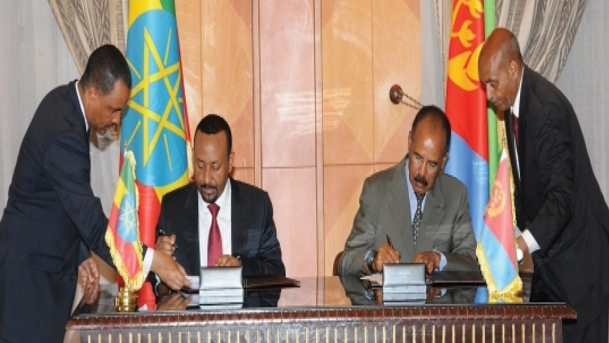
With In Ethiopia’s domestic politics, Eritrea historically has been used as tool in internal power struggles and political manipulation and one could plausibly argue that until Ethiopian politicians stop using Eritrea as a platform for their domestic political squabbles, peace between the two countries will remain elusive. Now, however, two decades of border war between Ethiopia and Eritrea have officially come to an end. (1) Normalization of relations has begun with the restoration of diplomatic ties, opening of borders and resumption of flights between Addis Ababa and Asmara. The present rapprochement has come about after a long-standing request for dialogue from Ethiopia had been continually rejected by Eritrea, in protest against Ethiopia’s refusal to hand over border areas awarded to Eritrea’s side by the International Court of Justice in 2005. In addition to the United States and others, Qatar took part in mediating the dispute. (2)
The paper seeks to define several propositions about seven key Issues, which must addressed before pursuing the normalization of the Ethiopian-Eritrean relations. First of them is to stop making use of Eritrean issues for internal power struggles within Ethiopia. Second is to recognize the primacy of arriving at a comprehensive treaty for sustainable, long-term peace and development for the two nations. Third is to put an end to any and all hostilities, including military operations and activities against each other, as well as cessation of all hostile media and other propaganda campaigns. Fourth is the demilitarization of the border area; fifth, an inclusive, transparent and all-encompassing Ethiopian government approach to any resolution of Eritrea-related issues. Sixth, a need for inclusive dialogue on all outstanding issues, in particular peace and security of the two peoples and states; and seven to accord priority to the interests of local communities in the border areas.
The 1998 Border War
The seeds of Eritrea’s 1998 war for independence were sown more than four decades earlier, with a hasty decision by the Ethiopian side to annul Eritrea’s membership of an Ethiopian federal system (arranged by the UN in 1952) and to formally annex the territory. (3) The decision seems to have been motivated in part by a miscalculation of its strength by the Ethiopian government, which to outsiders at least had appeared to be divided on ethnic lines. (4) The decision in turn triggered a civil war in Eritrea in the early 1960s. The contending Cold War powers used that conflict as a proxy war; in addition, Arab nationalists and the Egyptian state seized on it as a means to undermine the economic development of Ethiopia, and thereby to ensure exclusive use of the waters of the Nile. Neighboring countries such as Somalia and Sudan also encouraged the civil war as a way to weaken the position of Ethiopia’s central government in their long-running border disputes. (5) The policies of the so-called “Derg” Communist military junta in Ethiopia, which had come to power through the revolutionary overthrow of the Imperial regime in 1974, lost Ethiopia the international support it had formerly enjoyed for its claim on Eritrea.
By 1991, Derg had in turn been ousted by a coalition government of the Ethiopian People’s Revolutionary Democratic Front (EPRDF), which initiated peace feelers in the hope that a settlement between Ethiopia and Eritrea, would resolve the twin problems of the forcible separation of the two peoples and Ethiopia's loss of access to the sea. From that hopeful new beginning, however, the relatively peaceful relationship between Ethiopia and Eritrea turned into a full-scale, conventional war in 1998. (6)
Ethiopia was ill-prepared for such a conflict and at the time did not even have an army brigade on its border with Eritrea; (7) its defense spending amounted to little more than USD 100 million, a tenfold reduction from a decade before. (6) During the border war, Ethiopians’ fight to defend their national sovereignty was symbolized by the protracted battle for control of the border town of Badme. Eritrea, on the other hand, considered Ethiopia an invader. Over the entire period of the war an estimated 70,000 to 100,000 people were killed, another million displaced and a generation of development opportunities was squandered. (8) The cause of the war was sold to the general public and the international community as a “border dispute”; two years of intense fighting ended with the 2000 Algiers Peace Agreement, which officially put an end to hostilities and set out a resolution of the border dispute. (9)
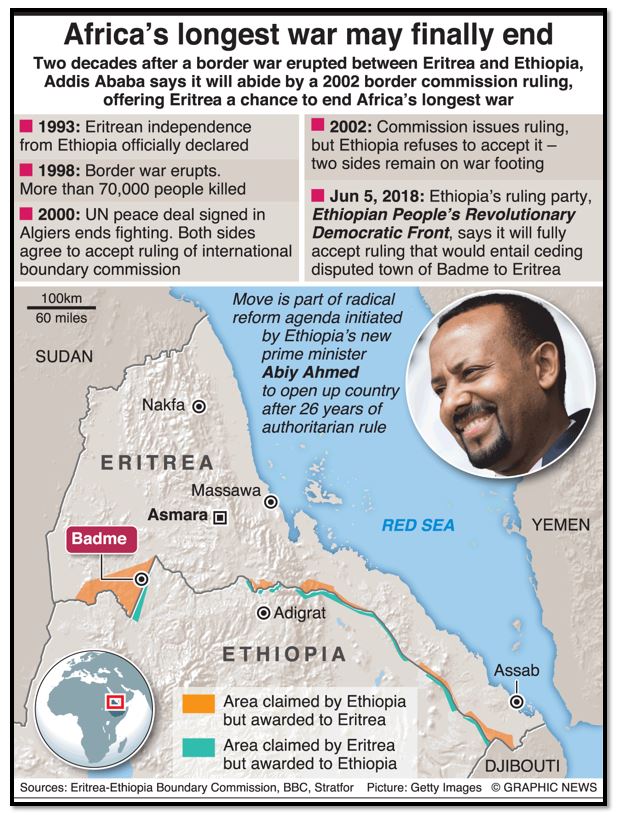 |
| Africa's Longest War [GraphicNews] |
Under Article 4 of the agreement, the Ethiopia and Eritrea Boundary Commission (EEBC) was charged to “delimit and demarcate the former colonial border based on pertinent colonial treaties (1900, 1902, and 1908) and applicable international law”, a determination that was final and binding. In awarding Bademe [sic], a small town at the center of the border war, to Eritrea, that determination represented a cardinal error in the Algiers Agreement, hence that of the EEBC. Badme became the symbolic center for the expression of all the many differences between Ethiopia and Eritrea. Popular legitimacy for the governments in both Addis Ababa and Asmara came to hang on the one small border town.
The Algiers Agreement and the EEBC Decision
Legal Precedence and Jurisprudence
The Algiers Agreement attempted to adjudicate the immediate triggers of war through the establishment of a border delimitation and demarcation commission and a claims commission, putting in place mechanisms for evaluating the impacts of the war on socio-economy, and creating a compensation commission. (10) However, it failed to address some root causes of the war, in particular the creation of a peaceful regional “neighborhood”, Ethiopia’s access to the sea and port services through the Eritrean port of Asseb, and the two countries’ economic interdependence. Not surprisingly, internal political and economic factors in each country proved to be the main problems in resolving the issues.
Perhaps because of the limited parameters laid down by the Algiers Agreement, the EEBC also failed to take into consideration the broader interests of the border populations most involved in the demarcation. (11) The human rights and consent of those affected by the new boundaries should have taken pride of place in the decisions of the EEBC. (12) Under their terms, individuals will be compelled to take a nationality not of their choosing, as formerly homogeneous communities are divided or isolated from the rest of the country and it is not surprising that the status of Badme and Asseb has been at the center of domestic political debate in Ethiopia. (13)
Concerns over unfair economic benefits, mistreatment of nationals, levies on exports and imports and the use of the new Eritrean currency, Nakfa, may have caused, triggered or accelerated the conflict. (14) In particular, several observers believe that ensuring Ethiopia’s access to the sea and port services played a major part in provoking the war. The secure and guaranteed access to the sea and port services that Ethiopia has enjoyed for centuries remains a key determinant of peace and development in the Horn of Africa region and some Ethiopian government officials have argued that a guarantee for port services for Ethiopia's 100 million population (expected to become 120 million by 2030) will remain critical to the region’s stability and development.
The EEBC decision was premised on two main issues: first, the provisions of existing colonial treaties and secondly, whether either party had established a credible administrative claim overriding those provisions. While awarding Badme to Eritrea, the Claims Commission (established under Article 5 of the Algiers Agreement) found Eritrea to be the aggressor triggering the border conflict by invading Badme, then administered by Ethiopia. The findings by the Claims Commission and the EEBC in effect contradicted each other.
A power struggle within the ruling EPRDF party and the political crisis that ensued meant that Ethiopia was ill- represented before the commissions, particularly with regard to submission of evidence in support of its administrative control of Badme. Furthermore, since the border war new realities have emerged in the national politics of Ethiopia. Badme has become a symbol of sovereignty and has itself expanded in both population and infrastructure. As previously noted, implementation of the EEBC ruling has proved difficult simply because it did not address the root causes of the war nor take into account the priorities, rights and concerns of the local populations.
Simple demarcation of borders and a pact between the capitals of the two countries that excluded the concerns of the border population would not of themselves bring about a sustainable peace, which could come only from an arrangement that prioritized the borderlands’ people and provided for the articulation of their needs. The Algiers Agreement and the EEBC decision each failed to provide such a foundation.
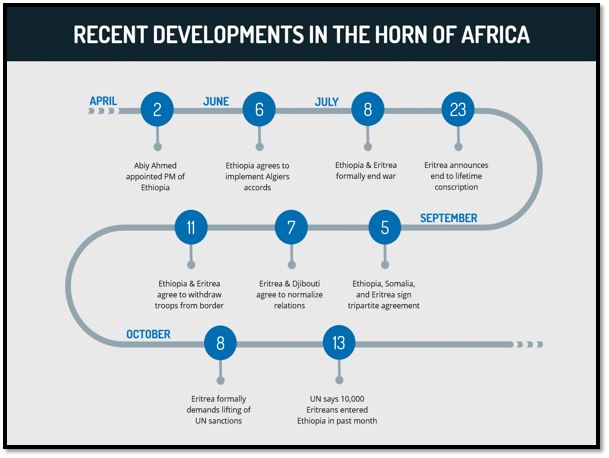 |
| Recent developments in the Horn of Africa [Maxswecurity] |
Learning rapidly the lessons of this tragic breakdown in a process, which was envisaged as exemplary, Ethiopia moved to adopt a diplomatic strategy that proved a major contributor to Eritrea’s eventual diplomatic isolation and economic and military deterioration. Its success in this eventually brought about the loss of Eritrea’s sources of aid from – and its cordial relationships with – Western nations and a few in the Middle East such as Qatar. (15) As a consequence of this isolation and of its parlous economic situation, Eritrea – economically struggling, politically unstable and diplomatically marginalized – has been reduced to what has variously been described as an African “garrison state” and the “pariah North Korea of Africa”. (16)
Troubling Historical Legacy: Eritrea as football in Ethiopian power politics
It may be recalled that the Algiers Agreement was signed at a time when Ethiopia’s ruling EPRDF party was in deep internal crisis. Similarly, current efforts directed to arriving at peace with Eritrea are occurring at a time when the country is in transition and the internal politics of the EPRDF remain divided, weak and uncertain.
As noted, Eritrea has long been a major element in Ethiopian internal politics. The 1952 federation that included Eritrea carried with it with serious political challenges to Ethiopia. The federation was tied to an undemocratic government in Addis Ababa and political forces in both Addis Ababa and Asmara were divided in their support for either a federation or a union. Hence the rapid failure of the arrangement was all but inevitable. Unionists and Federalists (the latter, later to become separatists), fought a battle in the Ethiopian political landscape that ended in a Unionist victory in 1962, when the proponents of federation were systematically thwarted. With this, the separatists began their armed secessionist struggle.
The Ethiopian political forces that came together to support the 1974 revolution which toppled the Imperial regime also fought each other, disagreeing on how to address the Eritrean question. An internal struggle within Derg in 1974-1978 led to the murder of its Eritrean chairman, General Aman Amdom, who was accused by one of his successors, Colonel Mengistu Haile Mariam, of siding with Eritrean secessionist rebel groups.
Non-state Ethiopian armed groups including the Tigray People’s Liberation Front (TPLF), the Ethiopian People’s Revolutionary Party (EPRP), the All-Ethiopia Socialist Movement (Meison) and the Olomo Liberation Front (OLF) among others, clashed ferociously. In Tigray region a battle between TPLF and EPRP ended in the latter’s expulsion from Tigray. It was this vicious circle of actions, counteractions and reactions that eventually led to the secession of Eritrea from Ethiopia in 1991.
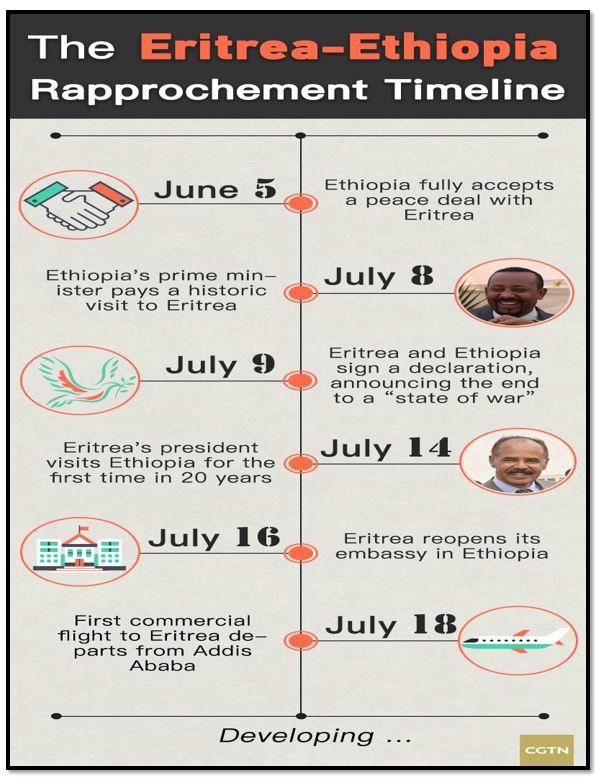 |
| The Eritrea-Ethiopia Rapprochement Timeline [NEWS.CGTN] |
With the fall of Derg in the same year, the newly formed EPRDF in Addis Ababa and its counterpart Eritrean People’s Liberation Front (EPLF) in Asmara came to power; Eritrea achieved de facto independence in 1991, confirmed by a formal declaration of independence in 1993 after a referendum conducted against a backdrop of political division and disagreement among Ethiopians on the fate of the two countries; in fact , differences arising from the 1998 border war eventually led to the TPLF’s split and that also divide EPRDF.
In similar vein, Ethiopia’s 2018 rapprochement with Eritrea is again being used as a political weapon to target internal political “enemies”, in this case TPLF and Tigray. One American hired-gun conciliation expert has emphatically pointed out that “Abiy Ahmed and [Eritrean president] Isaias Afewrki are racing toward peace because they both face the same threat: hard-liners in the Tigrayan [sic] People’s Liberation Front.” (17) TPLF, objecting to what it saw as the rapprochement with Eritrea being used as a political weapon in internal power struggles, released a statement opposing the decision by the new EPRDF leadership to accept and implement the Algiers Agreement and the decisions of EEBC. The party also called for an emergency meeting of the EPRDF Council, which did not materialize.n(18) This opposition from TPLF was partly a result of spontaneous protestsn(19) that occurred in Tigray’s urban areas against the decision by the federal government. Once again Eritrea had become a football in the kind of Ethiopian domestic political struggles that previously had led to the split in EPRDF.
Real Reasons behind the Policy Changes
In the “no war, no peace” stalemate following the end of the border war in 2000 and against the backdrop of Ethiopia’s successful policy of military containment and diplomatic isolation, the Eritrean army was weakened to the point where it was barely able to defend the country. (20) While containing Eritrea militarily could have been achieved by Ethiopia unilaterally, diplomatic isolation as a policy demands a multilateral approach to garner support from regional and global allies. The congruence of recent developments in the US, the EU, the Middle East and the Horn of Africa has, however, substantially eroded the effectiveness of Ethiopia’s long-standing policy on Eritrea, requiring it to make significant revisions and further attempt to mend relations. The new US-Africa policy (mainly resulting from a shift in US priorities from the so-called “war on terror” to containment of China and Russia), taken with the change of leadership in Ethiopia, has brought new realities on the ground. Consequently, in April 2018 the EPRDF executive committee issued a statement of the authorities’ intention to engage in negotiation with the people and government of Eritrea.
Eritrea responded positively to the initiative. High-level delegations from the two countries exchanged visits and on July 9 2018 a joint declaration of peace and friendship(21) was signed between the two countries in Asmara, and later in Jeddah. Among Ethiopians there was massive public support for the decision but concerns remained regarding border demarcation of some contentious areas such as Badme and the Tigray border town of Zalambessa. Although details have not been made public, seemingly the two countries have entered into multiple substantive agreements aimed at normalization of relations and cooperation, some of which reportedly were signed in Jeddah under the auspices of Saudi Arabia.
In practice, for normalization to work, two main issues behind the impasse between Ethiopia and Eritrea need to be addressed. The first is Eritrea’s demand for immediate and unconditional demarcation of the borders and for markers on the ground, particularly in Badme; the second is Ethiopia’s concern for long-term peace and the fate of inhabitants in border areas whose wellbeing might be significantly affected by border demarcation.
Eritrea’s Position: Change of Hands or Change of Heart?
Speaking to a 2013 AU Summit Ambassador Girma Asmerom, the Eritrean Permanent Representative to the AU, said: “I have been instructed by your brother, President Isaias Afwerki to assure you that if Ethiopia withdraws its army from occupied sovereign Eritrean territory including the town of Badme in the morning, dialogue between the two countries will start in the afternoon.” (22)
While this statement indicated Eritrea's willingness to enter into talks with Ethiopia, recognition of Badme as Eritrean territory remained a precondition. For its part, Ethiopia put dialogue and strategic peace as preconditions. It therefore came as a surprise when only five years later, Eritrea normalized its relations with Ethiopia without the Badme precondition; leaving the town, for now at least, under the Ethiopian government. What explains this change? One component could be the trust Eritrea now places in the new Ethiopian leadership and its pledges eventually to hand over Badme (23) but the main reason lies elsewhere: in the pressure brought to bear on Eritrea and Ethiopia by external powers.
External Actors
The independence of Eritrea in 1991, like the decision to federate Eritrea with Ethiopia in 1952 and the colonial establishment of Eritrea by Italy in 1890, was midwifed by external agencies, in that case including the UN, the US and former colonial powers. Similarly, the Algiers Agreement and EBBC are externally imposed solutions. As witnessed in various recent mediation meetings organized by UAE and Saudi Arabia and in US shuttle diplomacy, external actors have continued to play a critical role in rapprochement between the two countries.
On the genesis of the latest initiatives Fatemeh Salehi, writing in Modern Diplomacy, aptly comments: “At first glance, it seems as if the two countries realized the necessity of bilateral relations, but the fact is there was involvement of foreign countries in the peace talks. Some believe that Washington, an ally of Ethiopia, does not require the country to adhere to the border agreement. Perhaps the US has concluded that it is time to make a new alliance as Djibouti, located in the vicinity of Ethiopia and Eritrea, has allowed China to build a military base on its territory. So, given the geopolitical developments in the Red Sea and the Chinese military presence in Djibouti, America sees its interest [as] improving relations with Eritrea.” (24)
Good intentions notwithstanding, experience shows that external intervention has never brought peace to Ethiopia and intrusions by big powers as well as the influence of Arab and Moslem states in the region can only further complicate relations between Ethiopia and Eritrea.
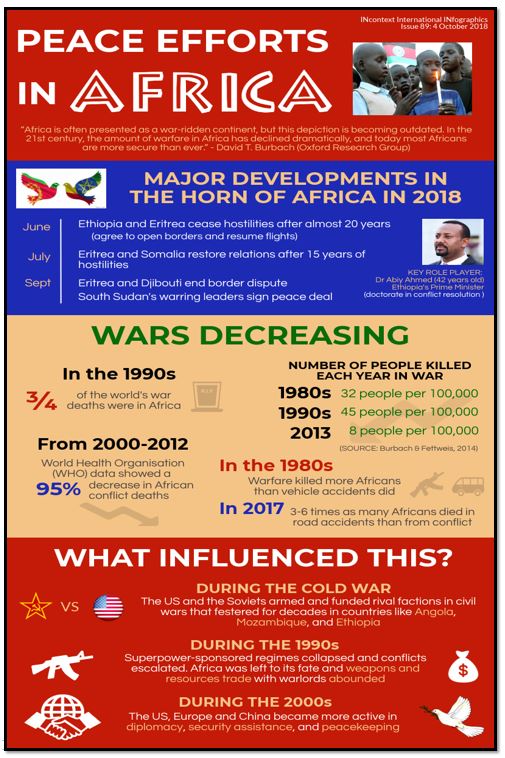 |
| Wars Decreasing in Africa [Incontext International] |
Necessary Changes
Clearly, citizens from either side wholeheartedly supported the search for a settlement of the conflict, seeing peace between Ethiopia and its neighbor generally as mutually beneficial. More particularly, a settlement will greatly benefit those people living in border areas that have borne the brunt of war and its aftermath. It is therefore timely and provides strong positive optics to current transitions in the region. Nevertheless, under the veneer of peaceful progress lies a smear of public distrust on the motives for the rapprochement. In the border areas of Tigray region, for example, there were massive protests prompted by misgivings concerning the motivations for the announcements from the EPRDF leadership. Such reservations stem from the history, old and recent, of the region.
Lessons from History
From an historical perspective, four critical issues raise difficulties. The first and most important lesson is that it is the immediate past that should inform the search for a peaceful solution to the Ethio-Eritrean conflict. The timing of the current process strongly rekindles memories of the Algiers Agreement, signed when the EPRDF was in deep crisis due to internal ideological and power struggles. In the same vein, current efforts to arrive at peace with Eritrea are being undertaken at a time when the country is in transition and the EPRDF’s internal politics remain divided, weak and volatile.
The immediacy of the timing and the hasty decision-making within which the rapprochement occurred betray a sense of political urgency. Against this background the country and its leadership are divided and consumed by other priorities, making it difficult for them to settle to talks of such importance and to advance calm and well considered positions representing Ethiopia’s best interests. If lessons from the past are to inform the present search for a peaceful accommodation, Ethiopia’s leaders must consult, institutionalize and offer a degree of transparency on the negotiations.
In the current Ethiopian and Eritrean political atmosphere many forces have become prisoners of their own internal and partisan political positions, hindering vision-based deliberation and action on future relations that would take into account the two nations’ long-term national and regional interests.
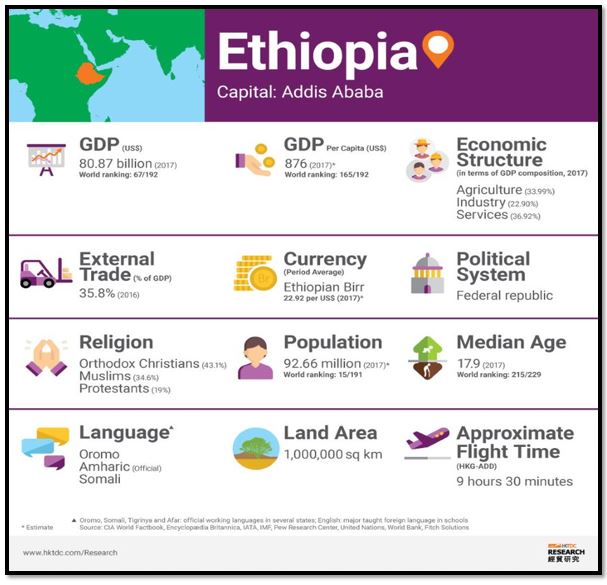 |
| Ethiopia Data [Getty] |
The second important historical lesson is that an arrangement based solely on goodwill between two leaders will have dire consequences unless it is fully owned and supported by the local population in the border areas. While current initiatives are indeed long overdue, for them bring a sustainable peace, effectively implemented, there needs to be sufficient trust built between the two countries generally and in particular the populations in the border areas. Furthermore, implementation of any border arrangement necessarily is local in nature, so the involvement of local authorities in all agreements on such issues is vital for successful resolution and long-term stability. Such local-level consultations would help forge a vision for a common future between the two countries and peoples.
The third historical lesson relates to the fact that the involvement of external actors further complicates the problem. The conclusion here would that Ethiopia and Eritrea can and should not expect a sustainable peace if it is brokered by external actors, especially those with strategic interest hostile to Ethiopia (particularly Middle Eastern countries). Rather the solution should come only from a genuine effort from the two sides concerned.
Although seldom spoken of, the border populations in Eritrea and Ethiopia still share many peaceful interactions. While casualties arising from war in the border areas – among both combatants and non-combatants – are extremely high, a disproportionate number falls on the people of Tigray and Afar. Despite this, older and more recent wars in Eritrea have never succeeded in destroying the cultural and social relations between the people across what is essentially an “artificial” border; there are still remarkable stories of strong people-to-people ties in those areas. They have been interacting with each other and continue to do so even during their darkest hours and they still share both the joys and sorrows of life. Such evidence of cordial relations should serve as bedrock for sustainable peace between the two states.
The lesson here is that Ethiopia and Eritrea should not envisage sustainable peace to be brokered by external actors. Rather the solution should come from a genuine effort from both sides. Furthermore, implementation is local, thus the involvement of local authorities in the implementation of all agreements on border issues is vital for successful resolution and long-term stability.
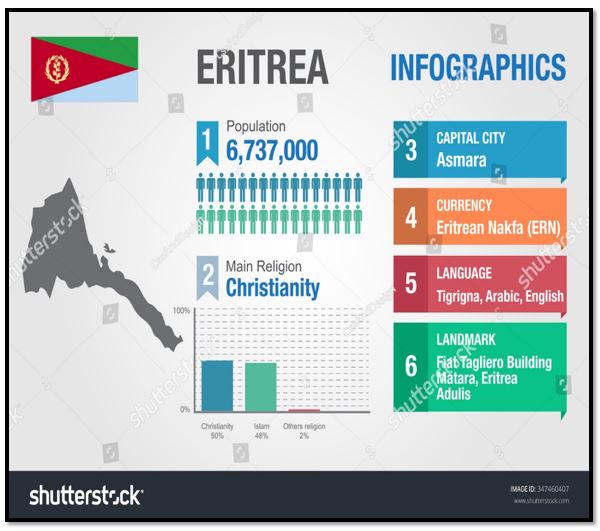 |
| Eritrea data [Getty] |
The fourth lesson relates to a lack of transparency and consultation. Eritrea has been the catspaw of internal Ethiopian power struggles for decades and it should now be recognized that transparency around the agreements is a key component without which sustainable “normal” relations are unthinkable. Within EPRDF the Ethio-Eritrean file has always been handled under a cloak of absolute secrecy – an old habit that has escaped the reformers’ net. Secrecy of this kind during EPRDF internal political struggles inevitably invites public suspicion, speculation and distrust. In the absence of transparency, speculation fills the information gap and fuels swirling public distrust. This is precisely what is now happening in Tigray region with regard to the recent rapprochement between Addis Ababa and Asmara without the participation of Mekelle (the Tigray capital) and Asaita, the former capital of Afar region.
Outstanding Issues
If they are to avoid a repeat of history, the federal government of Ethiopia and the state of Eritrea each need to adopt a clear roadmap for building mutually assured peace and development options for their peoples. Such a plan must identify all outstanding issues and lay out the key principles upon which the process can be anchored.
For previously noted historical, demographic, economic and legal reasons the two governments should first address a range of outstanding issues that can be unbundled into four categories: respectively border dispute, sustainable peace, human rights of the border communities, and Ethiopia’s access to the sea and port services:
• Border dispute: It is unavoidable that any sustainable peace depends on good border governance and the attainment of sustainable development in border areas. Without the active participation of communities in those borderlands, implementation of any agreement on borders will be difficult. It is critically important that consultations to identify the steps necessary to defining the borders between the two countries are inclusive and transparent.
• Sustainable peace: There must be a declaration of cessation of hostilities by both parties in every domain including land and air communications and media; a formal peace treaty; demilitarization of the border areas; and programs for establishing economic development zones in border areas.
• Human rights and primacy of local populations’ interests: The fate of those inhabitants in border areas who might be significantly affected by border demarcation must be taken into account in consultations with local communities affected by decisions of the Boundary Commission. For this initiative to be effectively implemented, an appropriate degree of mutual trust needs to be built between the two countries and their border area populations.
• Guaranteed access to the sea and port services: Ethiopia’s concerns over secure and guaranteed access to the sea and associated port services should be taken fully into consideration. For centuries, such access for Ethiopia has remained a key determinant of peaceful development in the Horn of Africa. Provision of relevant guarantees would ensure that Ethiopia plays its full part in the stability and development of the Horn of Africa.
Recommendations
The recent rapprochement between Ethiopia and Eritrea, despite some serious shortcomings, could put countries of the Horn of Africa generally on the path to regional peace. It is critically important to this scenario that having due regard to their history, Ethiopia and Eritrea begin a new chapter of mutual respect, cooperation and peaceful relations. No peace initiative should be allowed to fall short of the simple target of sustainable, comprehensive peaceful development in the region: their peoples deserve no less. Accordingly, in taking account of the complex concerns resulting from their mutual historical ties, the two countries must consider the following seven recommendations. They each should:
1. Maintain the highest possible degree of transparency by openly and officially publishing all agreements reached and signed between Ethiopia and Eritrea;
2. Negotiate a long-term comprehensive peace and mutual development treaty for the resolution of Ethiopia-Eritrean hostilities that addresses all outstanding issues and provides a short-, medium- and long-term vision for peaceful coexistence and cooperation between the two countries. Such a treaty should be seen as a blueprint for the resolution of border issues with other neighboring countries, hence would need to be anchored on three AU core principles:
The principle of negotiated settlement of border disputes;
The principle of respect for territorial integrity and borders; and
The primacy of sustainable and long-term peace and development.
3. After signing the treaty, ensure complete demilitarization of the border areas;
4. Urgently convene and facilitate national and local level consultation forums, through which all stakeholders can be engaged on a roadmap for Ethiopia’s building a sustainable peace with Eritrea;
5. Declare and sign an agreement on cessation of intrusions and hostilities against all parts of Ethiopia including bordering regional states;
6. Urgently convene and facilitate consultations between border populations in either side and organize exchange visits in border areas;
7. Incorporate regional states into meetings of joint bilateral border commission meetings between Ethiopia and its neighboring countries, acknowledging that Afar and Tigray regional states in particular must be fully consulted on the nature and content of any agreement.
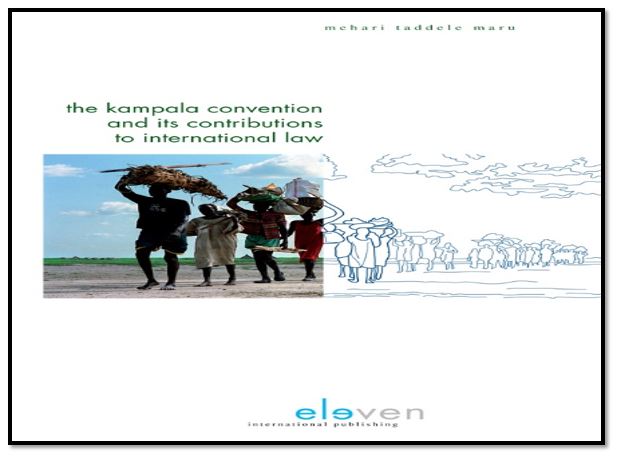 |
| Dr. Maru's book |
(1) BBC Ethiopia Eritrea, available from http://news.bbc.co.uk/2/hi/africa/280267 .stm (accessed 12 February 2019); State of Eritrea, available from http://www.shabait.com/news/local-news/26639-joint-declaration-of-peace-and-friendship-between-eritrea-and-ethiopia (accessed 12 February 2019).
(2) Awate, available from http://awate.com/eritrean-strongman-asks-qatar-to-mediate-dispute-with-ethiopia/ (accessed 12 February 2019).
(3) Erlich, Haggai 1983The Struggle over Eritrea, 1962-1978: War and Revolution in the Horn of Africa, Stanford, CA: Hoovers Institute Press.
(4) Erlich, Haggai 1983The Struggle over Eritrea, 1962-1978: War and Revolution in the Horn of Africa, Stanford, CA: Hoovers Institute Press.
(5) Dorman, Sara Rich 2003 “Eritrea’s Nation and State-building: Re-assessing the impact of ‘the struggle’” available from https://econpapers.repec.org/paper/qehqehwps/qehwps105.htm (accessed 12 February 2019).
(6) John Abbink, 1998 “Briefing: The Ethio-Eritrean Border Dispute,” African Affairs, Vol 97.
(7) Mehari Taddele Maru, 2017, A Regional Power in the Making: Ethiopian Diplomacy in the Horn of Africa, available from https://saiia.org.za/research/a-regional-power-in-the-making-ethiopian-diplomacy-in-the-horn-of-africa/ (accessed 12 February 2019).
(8) International Crisis Group, 2008 “Beyond the Fragile Peace Between Ethiopia and Eritrea: Averting new war.”
(9) The Agreement on the Cessation of Hostilities between the Government of the Federal Democratic Republic of Ethiopia and the Government of the State of Eritrea, Algiers, 18 June 1998, available from http://untreaty.un.org/unts/144078_158780/17/8/8238.pdf (accessed 12 February 2019).
(10) Andreas Eshete 1998, “The Ethio-Eritrean Conflict: Political and Legal Dimensions,” Cambridge: Harvard University, Centre for International Affairs.
(11) Terrence Lyons 2009, The Ethio-Eritrean Conflict and the Search for Peace in the Horn of Africa.
(12) UN Monitoring Group on Somalia and Eritrea, Letter from the Chairman of the Security Council Committee pursuant to resolutions 751 (1992) and 1907 (2009) concerning Somalia and Eritrea, UNSC S/2011/433, 18 July 2011.
(13) Bilal Derso, available from https://allafrica.com/stories/201808010301.html
(14) Gilkes, Patrick and Martin Plaut, 1999, War in the Horn: The Conflict between Eritrea and Ethiopia Chatham House.
(15) David Shin, 2014, available from https://africanarguments.org/2014/01/13/time-to-bring-eritrea-in-from-the-cold-but-its-harder-than-it-sounds-by-david-shinn/
(16) Kjetil Tronvoll and Daniel Mekonnen, 2014, The African Garrison State: Human Rights and Political Development in Eritrea, James Currey, available from http://www.academia.edu/10255884/The_African_Garrison_State_Human_Rights_and_Political_Development_in_Eritrea_Kjetil_Tronvoll_and_Daniel_R_Mekonnen_James_Currey_2014
(17) Bronwyn Burton, 2018, Ethiopia and Eritrea have a common enemy, available from https://foreignpolicy.com/2018/07/12/ethiopia-and-eritrea-have-a-common-enemy-abiy-ahmed-isaias-afwerki-badme-peace-tplf-eprdf/
(18) Habtom Mehari, Eritrea and Ethiopia: A Peace Deal or Tactical Alliance, available from https://www.jpost.com/Opinion/Eritrea-and-Ethiopia-A-peace-deal-or-tactical-alliance-562511 (accessed 12 February 2019).
(19) Eric Oteng, Ethiopia’s peace deal with Eritrea criticized by TPLF, available from http://www.africanews.com/2018/06/14/ethiopia-s-peace-deal-with-eritrea-criticised-by-tplf/ (accessed 12 February 2019).
(20) Abel Abate 2011, Eritrea: Regime and Its Relations with outside world, available from
https://allafrica.com/stories/201106291331.html (accessed 12 February 2019).
(21) State of Eritrea, available from http://www.shabait.com/news/local-news/26639-joint-declaration-of-peace-and-friendship-between-eritrea-and-ethiopia (accessed 12 February 2019).
(22) State of Eritrea, available from http://www.shabait.com/news/local-news/12383-statement-by-he-ambassador-girma-asmerom-at-the-african-union-summit-28-january-2013-addis-ababa-ethiopia (accessed 12 February 2019).
(23) Ethiopia vows to give disputed Bademe town to Eritrea, available from https://www.voanews.com/a/ethiopia-vows-to-give-disputed-badme-town-to-eritrea/4425902.html (accessed 12 February 2019).
(24) Fatemeh Salehi, Saudi Arabia, UAE Footprint in Eritrea Ethiopia Rapprochement, Modern Diplomacy, available from https://moderndiplomacy.eu/2018/07/13/saudi-arabia-uae-footprint-in-eritrea-ethiopia-rapprochement/ (accessed 12 February 2019).
